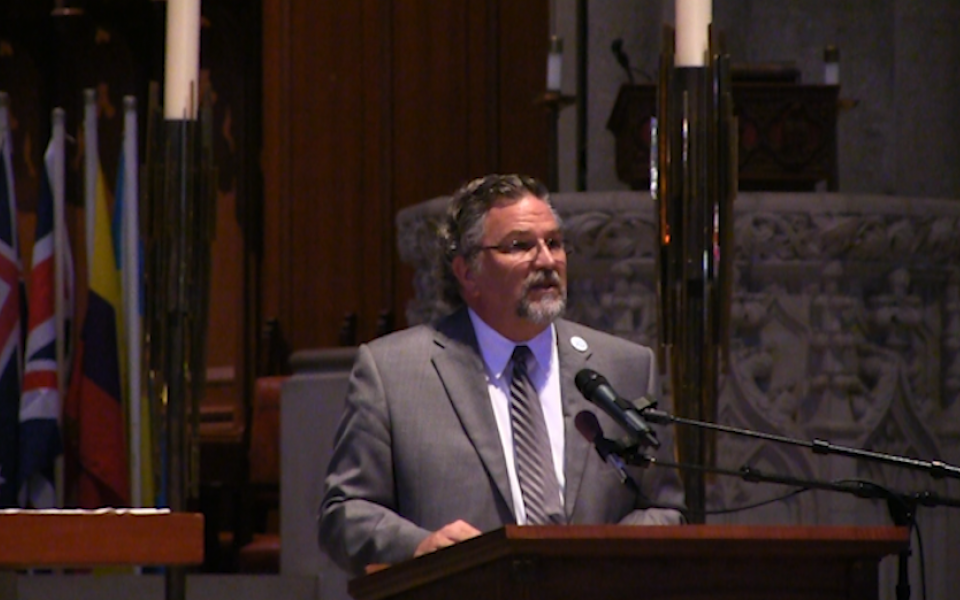
UN 70th Anniversary and URI 15th Anniversary Celebration
Remarks by The Rev. Victor Kazanjian,
Executive Director, United Religions Initiative
“You wake from dreams of doom and--for a moment--you know: beyond all the noise and the gestures, the only real thing, love's calm unwavering flame in the half-light of an early dawn.” ? Dag Hammarskjöld, Markings.
Good afternoon, my friends. It is such a pleasure to be with you today on this day of celebration. Today is such an exciting day, a day of looking back to the original vision that led to the formation of the United Nations. Today, we also celebrate the original vision that led to the founding of the United Religions Initiative, this extraordinary global grassroots interfaith movement spanning 85 countries that I have the honor of directing. Today we look back at where we have been and also we look ahead to the important partnership between the United Nations and Interfaith Organizations in bringing peace to our troubled world.
For those who do not know the purpose of the Untied Religions Initiative is to unite people of diverse religions, spiritual expressions and Indigenous traditions to promote enduring daily interfaith cooperation, to end religiously motivated violence and to create cultures of peace, justice and healing for the earth and all living beings.
I love this purpose statement. I have spent the first year and a half of my tenure as Executive Director of the URI traveling the world and listening to stories of acts of courage and daring carried out by people of different religious, spiritual and cultural groups working together to confront violence and injustice in their communities. It has been so inspiring to witness the work of countless numbers of community activists forging bonds of alliance across lines of difference and forming powerful coalitions to create change in their communities, to build interfaith partnerships and address the root causes of conflict.
What has struck me as particularly important about this work is that the power behind this peacebulding is as much about relationship and human connection as it is about politics and strategy. Without the power provided by human connection, the most sophisticated strategies are but hollow branches bracing against the strong winds of injustice and violence.
Violence and injustice require the dehumanizing of the other. We know this – in both interpersonal and geopolitical contexts. Therefore, an essential component of all peacebuilding and justice-seeking is the rehumanizing power of the very human qualities of love, compassion and empathy.
“You wake from dreams of doom and--for a moment--you know: beyond all the noise and the gestures, the only real thing, love's calm unwavering flame in the half-light of an early dawn."
There is a picture on the wall of my office that was given to me by a friend who is an astronaut. It is a picture that she took from the space shuttle, which she was piloting, a picture of the earth from deep in space. Perhaps you have seen something similar. The blue, green earth, a perfectly round ball floating in a sea of black…, earth and ocean the only visible distinguishing features. It is a magnificent image, so beautiful, so peaceful, so serene.
Gazing upon that image, it seems unfathomable that upon that beautiful sphere moving through the universe, its inhabitants are locked in life and death struggles with each other. From thousands of miles up in space one is free from the sounds and stench of war and violence, of poverty and oppression, of misogyny and prejudice that plague the peoples of this planet. Reading the daily papers or watching the news rife with stories of this violence, one perhaps yearns for such distance from the suffering below.
But if this was our only view of humanity, as an observer from so far away out in space, we would be unaware that on this same planet, amidst the violence, miracles are occurring every second. At this very moment, new life is being born in India, Pakistan, Nepal and Sri Lanka, in Iraq, Iran and the United States, in Uganda and Nigeria, Argentina and Chile, in the Philippines and Malaysia and to Palestinian and Israeli families. And in each of these places and so many more, people are engaging in acts of compassion and kindness. In each of these places, people are falling in love and forming friendships. And in many of these places people of different religious and cultural traditions who are part of URI are gathering in circles in their communities to forge bonds of friendship and create cultures of peace, justice and healing.
When we look at the earth from the distance of thousands of miles up in space or the closeness of sitting in a circle of friends and colleagues, we need to see not just the potential for peace, but the reality of peace. We know that peace is not just that which we seek, but that which we know in the embrace of a loved one, through the warmth of friendship, in extending oneself in compassion and empathy towards a stranger, in standing together against violence, injustice and oppression, and in working for interfaith and intercultural understanding and cooperation.
The person who most inspired my life’s work was Dr. Howard Thurman. I knew Dr. Thurman when he was in Boston, but many of you knew him or know of him from his days at the Church for the Fellowship of All Peoples in San Francisco.
Listen to these words from Dr. Thurman.
“There is a sense of wholeness at the core of humanity
that must abound in all we do…
that lasts beyond the living and the dead,
beyond the goals of peace, the ends of war!
This we seek through all our years;
to be complete and of one piece, within and without."
We who do the work of peacebuilding usually focus on the external part of that equation – peace without, believing that it is the systems and structures of society that are both the cause of violence and injustice and its remedy. And this is not wrong. For the earth is in fact a connected whole, a system, a “global commons,” a shared space in which limits on resources and the environment are planetary, economies as well as human systems are inextricably interconnected, and human diversity is ever more apparent among the occupants of this our island home.
There is no question that to be of one piece without – requires our attention to all of those systems which shape our lives as human beings. This is the work that so many of us have been engaged in for so long. It is crucial work. And in the face of so many urgent external threats in areas of health, the environment, economies, human rights, political instability, and regional and global aggression, it is understandable that our focus would be drawn to the world without, and that our work would involve conceiving instruments of peacebuilding that engage these issues and create the conditions for peace and human security.
But when we focus only on the instrumental mechanisms of peacebuilding, we fail to harness what may be the greatest power at our disposal to create cultures of peace, justice and healing for the Earth and all living beings. This power, as Dr. Thurman teaches us, emanates from the world within.
Go beyond the goals of peace. Go beyond the ends of war – Be complete and of one piece within and without. That is what we are challenged to do today and in the days ahead… to go beyond our familiar conversations about ending war and violence and establishing peace through merely instrumental means, and envision a new paradigm, an approach to peace that is about completeness, about wholeness within and without; a peace where strategies are based on the values of love, compassion and empathy, and are rooted in the spiritual principles that ground our common life on this planet.
It is in the partnerships between the United Nations and Interfaith Organizations that the power of external peacebuilding and the power of internal peacebuilding come together. This is the partnership that I have witnessed between URI and the UN through programs like the International Day of Peace and Interfaith Harmony week. This is the partnership that I have witnessed between URI Cooperation Circles and UN agencies realizing the potential of grassroots interfaith groups
"There will be no peace among nations without peace among religions." proclaimed Hans Küng
If we weave together such practices with the plethora of extraordinary peacebuilding strategies available to us, if we combine our efforts working together as partners in one movement sharing connection to common values, the United Nations and the United Religions – then this movement of which we are a part will be fully energized to transform a struggling world into a truer reflection of the wholeness that lies at its core.
My sisters and brothers, may the power of love infuse purpose into our actions that we may be part of extending the reality of the peace that we know in our hearts to this precious planet and its beloved inhabitants.
May we know peace within ourselves.
May we know peace with one another.
May we know peace among the peoples of the planet.
Central to the work of the United Religions Initiative are the core practices that bring people of different religions, spiritual expressions and Indigenous traditions together in a common force for peace and justice. One of these practices is called Appreciative Inquiry and one of the finest practitioners of Appreciative Inquiry on the planet is URI’s Co-director of Global Programs, Sally Mahé.
See video and photos from Sally Mahé's Appreciative Inquiry session, and see video and text from the Right Rev. William E. Swing, URI President and Founding Trustee's speech.
